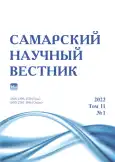Генетические маркеры доместикации (особенности интерпретации лабораторных данных палеогенетических исследований)
- Авторы: Кузнецов П.Ф.1, Фоменко С.В.1
-
Учреждения:
- Самарский государственный социально-педагогический университет
- Выпуск: Том 11, № 1 (2022)
- Страницы: 195-200
- Раздел: Исторические науки
- URL: https://journals.rcsi.science/2309-4370/article/view/108343
- DOI: https://doi.org/10.55355/snv2022111207
- ID: 108343
Цитировать
Полный текст
Аннотация
Статья-обзор рассматривает опубликованные в 2021 году в журнале «Nature» выводы двух исследовательских групп, в фокусе внимания которых находятся генетические аспекты проблемы доместикации лошадей в бронзовом веке. Достижение когерентности и преодоление противоречий данных палеогенетики и археологии посредством мета-описания, в основе которого лежит превалирование селекции, оборачивается рядом спорных выводов, среди которых: экстраполяция, вызванная переносом антропоморфических характеристик на физиологические особенности лошади, и редукция акторов социальных процессов к их генетическим маркерам. В контексте работ по медицинской генетике и социологии науки предполагается разрешение соответствующих противоречий через смену оптики анализа генетических данных в проблеме одомашнивания: отказ от мета-описания исследуемых явлений и актуализация логики встречи социальных потребностей с предшествующей одомашниванию мутационной изменчивостью. Кроме того, в статье рассматривается проблема интерпретации генетических данных одомашнивания лошади лишь как гипотеза. Проблема заключается в том, что между генетическими предшественниками и подлинными домашними лошадьми (Dom-2) существует значимый хронологический разрыв в 500–700 лет. В данный период входят такие значимые археологические культуры, как абашевская, постполтавкинская, волго-уральская и другие.
Ключевые слова
Полный текст
Открыть статью на сайте журналаОб авторах
Павел Федорович Кузнецов
Самарский государственный социально-педагогический университет
Email: pavelf.kpf.kuznetsov@gmail.com
кандидат исторических наук, доцент, заведующий музеем археологии Поволжья
Россия, СамараСергей Владимирович Фоменко
Самарский государственный социально-педагогический университет
Автор, ответственный за переписку.
Email: fomenko.f2013@yandex.ru
внештатный сотрудник музея археологии Поволжья
Россия, СамараСписок литературы
- Latour B., Woolgar S. Laboratory life. The social construction of scientific facts. London: Sage Publications; Beverly Hills: Calif, 1979. 272 p.
- Librado P., Khan N., Fages A. et al. The origins and spread of domestic horses from the Western Eurasian steppes // Nature. 2021. Vol. 598. P. 634-640. doi: 10.1038/s41586-021-04018-9.
- Wilkin Sh., Miller A.V., Fernandes R. et al. Dairying enabled Early Bronze Age Yamnaya steppe expansions // Nature. 2021. Vol. 598. P. 629-633. doi: 10.1038/s41586-021-03798-4.
- Gaunitz C., Fages A., Hanghøj K. et al. Ancient genomes revisit the ancestry of domestic and Przewalski’s horses // Science. 2018. Vol. 360 (6384). P. 111-114. doi: 10.1126/science.aao3297.
- Кореневский С.Н., Калмыков А.А. Майкопские погребения кургана 22 могильника Айгурский-2 // Российская археология. 2017. № 4. С. 106-124.
- Suri P., Palmer M.R., Tsepilov Ya.A. et al. Genome-wide meta-analysis of 158,000 individuals of European ancestry identifies three loci associated with chronic back pain // PLoS Genetics. 2018. Vol. 14. doi: 10.1371/journal.pgen.1007601.
- Jiang H., Moro A., Liu Y., Wang J., Meng D., Zhan X., Wei Q. Two GWAS-identified variants are associated with lumbar spinal stenosis and Gasdermin-C expression in Chinese population // Scientific Reports. 2020. Vol. 10. doi: 10.1038/s41598-020-78249-7.
- Horse Anatomy: Clinical atlas / ed. T. McCracken, R. Kainer. Lovеland: Alpine Publication, 1998. 181 p.
- Luria A.R. The neuropsychology of memory. New York: Halsted Press, 1976. 372 p.
- Bergson H. Creative evolution. New York: Henry Holt and Company, 1911. 407 p.
- Yoxen E.J. Constructing genetic diseases // The problem of medical knowledge: examining the social construction of medicine / ed. P. Wright, A. Treacher. Edinburgh: Edinburgh University Press, 1982. P. 144-161.
- Kerr A. (Re)constructing genetic disease: the clinical continuum between cystic fibrosis and male infertility // Social Studies of Science. 2000. Vol. 30, iss. 6. P. 847-894. doi: 10.1177/030631200030006002.
- Grubhoffer V. Pod závojem smrti: Poslední věci Schwarzenbergů v letech 1732-1914. České Budějovice: Společnost pro kulturní dějiny, 2013. 444 p.
- Holden C., Mace R. Phylogenetic analysis of the evolution of lactose digestion in adults // Human Biology. 2009. Vol. 81 (5-6). P. 597-619. doi: 10.3378/027.081.0609.
- Mace R. Update to Holden and Mace's «Phylogenetic analysis of the evolution of lactose digestion in adults» (1997): Revisiting the coevolution of human cultural and biological diversity // Human Biology. 2009. Vol. 81 (5/6). P. 621-624. doi: 10.3378/027.081.0610.
Дополнительные файлы








